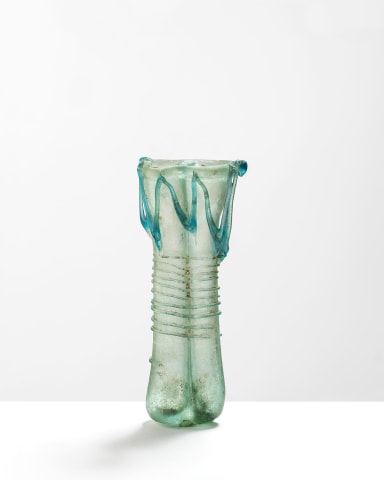166. Roman double balsamarium, c.4th century AD
%3Cdiv%20class%3D%22title_and_year%22%3E%3Cem%3E166.%20Roman%20double%20balsamarium%3C/em%3E%2C%20%3Cspan%20class%3D%22title_and_year_year%22%3Ec.4th%20century%20AD%3C/span%3E%3C/div%3E%3Cdiv%20class%3D%22medium%22%3EGlass%3C/div%3E%3Cdiv%20class%3D%22dimensions%22%3EHeight%3A%2010.9cm%3C/div%3E%3Cdiv%20class%3D%22price%22%3E%C2%A3%201%2C800.00%3C/div%3E
Free-blown pale blue glass, comprising of two slender tubes fused together, slightly flaring at both the top and bottom, the lip everted and folded, the base slightly flattened. Thick blue...
Free-blown pale blue glass, comprising of two slender tubes fused together, slightly flaring at both the top and bottom, the lip everted and folded, the base slightly flattened. Thick blue trailing applied in diagonal lines between the upper third and the lip, with thinner blue trailing beneath applied in spiral form around the centre of the tubes. Losses to the trailing, otherwise intact.
Provenance
R.J.H. Ramselaar, Blaricum, the Netherlands
Mrs Elias-Vaes, the Netherlands; acquired prior to 1970
Her sale; Christie’s, Amsterdam, the Netherlands, 27th, 28th and 29th April 2010
Sheikh Saud Al-Thani (1966-2014), London, UK and Paris, France
Exhibitions
Rotterdam, Historisch Museum, Bezeten Bezit, Keuzetentoonstelling uit de verzameling van Mevrouw W.G. Elias-Vaes te Rotterdam, exhibition catalogue, 18th April-1st August 1970, no.787
Literature
Compare an example at the Metropolitan Museum of Art, New York, USA, object number X.21.159
Publications
Christie's, Amsterdam,Twenty Rooms: The Private Collection of the late Mrs Elias-Vaes; 27, 28 and 29 April 2010, lot 77
